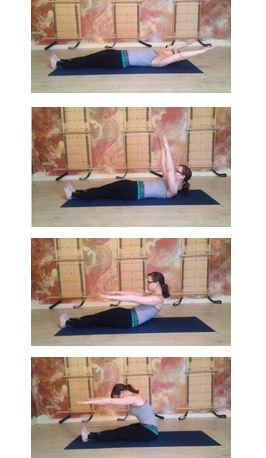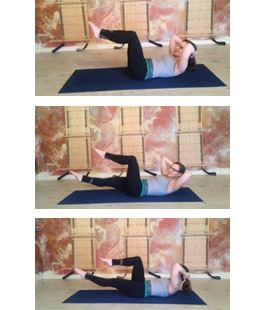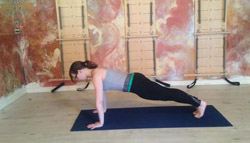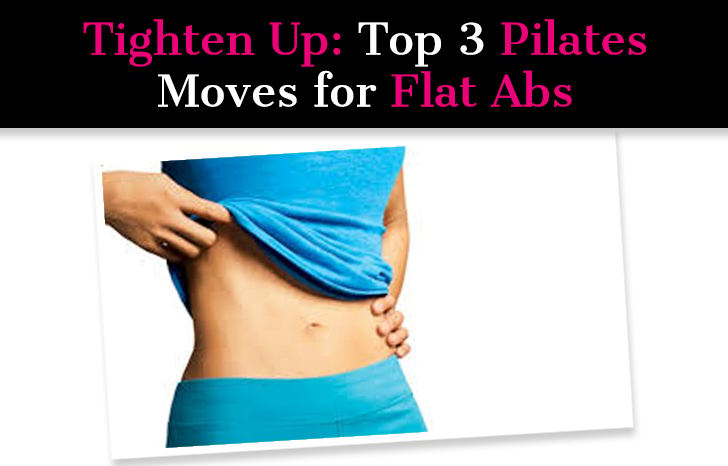Cardio workouts are a great way to shed pounds, but my favorite way to tone up is by focusing on deep core muscles. Pilates exercises develop a strong core connection through a full-body workout.
We all hear talk about the core, but many don’t realize the core goes beyond abdominals. As defined in Pilates, specific muscles make up the core: the transversus abdominis, your internal abs; the pelvic floor, at the base of your abs and attached to the pelvis; the diaphragm, which extends across the bottom of the rib cage and is used for breathing; and the multifidus, a small but powerful muscle that supports your spine. Essentially, these muscles are in charge of stabilizing your trunk and pelvis, so a strong core will enhance balance and stability as well as help prevent injuries.
Pilates exercises are a great way to get you to a flat tummy because of their abdominal focus and overall core challenge. In addition to all the core muscles already mentioned, Pilates exercises can challenge the rectus abdominis, your superficial abs, and the obliques, your lateral abs. When engaging your core, imagine a corset around your waistline hugging your abs in towards your spine.
Want to give your abs a run for their money? Here are three of my favorite ultra-challenging Pilates exercises. As you work through them, pay attention to detail by beginning with a slow and steady pace.
1. THE ROLL UP

How it works: Lie on your back with your legs together and extended on the mat. Reach your arms above your head so they’re resting on the mat, with your fingertips pointing towards the wall behind you, palms up. (Your arms may not be able to reach all the way to the floor.) Keep your back ribs connected to the mat. Inhale deeply to connect to your core as you raise your arms up over your head, fingertips pointing towards the ceiling. Softly engage your inner thighs as you flex through your feet. Then nod your chin and stretch your arms towards your toes. Exhale to begin peeling one vertebra at a time off of the mat, sinking your navel in towards your spine and stretching your fingers to your toes. Continue until you are sitting directly over your sitz bones (sitting bones), maintaining the curve of your spine as if you are rounded over a big ball.
Inhale to deepen your core as you begin to roll back by tilting your hips back, maintaining the same C-curve in your spine. Exhale as you complete the roll down until you’re back to the starting position. Repeat 3-5 times.
Benefits: Strengthens abdominals
Increases flexibility of the spine
Imagery: Imagine you’re wearing a striped shirt and are peeling one stripe at a time off of the mat.
Tips:
*Keep your arms connected to your shoulders, and your shoulders away from your ears.
*Stay soft in your hip flexors by anchoring your legs down to access your hamstrings.
*Use your breath to sink your ribs down as you begin the roll up.
*Keep your chest broad.
Modifications: A theraband is a useful tool that provides feedback and resistance. Wrap the band around the top half of your foot, making sure it’s wide, and holding each end with your hands.
MORE: Easy Tips to Get Your Body Bikini Ready
2. CRISS CROSS

How it works: Lie on your back in your neutral spine and pelvis position with your hands behind your head, knees bent, and feet flat on the mat (to identify neutral position, lie on your back and find the point where your hip bones and pubic bone are parallel to the mat. Your spine should maintain its natural curves where your sacrum, thoracic spine, shoulders, and back of the head are in contact with the mat. Your lumbar and cervical spine should maintain a slight arch off of the mat). Inhale and slightly nod your chin, sending your gaze towards your thighs. Exhale to engage your core, curling your head, neck and shoulders off of the mat. Pause here to inhale deeply, then exhale as you raise your knees directly over your hips, keeping your heels in line with your knees. This position alone can be challenging to sustain.
On your next exhale, deepen your core activation to twist through your thoracic spine by sending your right rib towards your left knee and keeping your elbows wide. Simultaneously stretch your opposite leg straight out. Inhale to rotate through center, exhaling to send your left rib towards your right knee while switching legs. Repeat 8-10 times.
Benefits:
Develops pelvic stability
Strengthens all of the abdominal muscles
Works on core control
Imagery: Imagine you’re balancing a tall glass of wine on your pelvis. Don’t spill it!
Tips:
*Let your hands support the weight of your head by relaxing your shoulders and neck, keeping your elbows in your peripheral vision.
*Stay wide through your collarbone, leading the twist with your chest.
*Keep both shoulders off of the mat the entire time.
*Focus on lengthening your body from the crown of your head to the tip of your toes.
*Keep your pelvis centered and still as you maintain a supported neutral position.
*Think about connecting your ribs towards your abs to maintain the chest lift.
Modifications: As you straighten the leg out, start at a high diagonal from your pelvis. This position will keep the strain out of the lumbar spine and keep the focus on the abdominals. As your core stability improves, you can challenge yourself by lowering your leg further down towards the floor.
MORE: How to Banish Belly Bloat
3. PLANK

How it works: Find your all-fours position, aligning your wrists with your shoulders and your knees with your pelvis, sitz bones distance apart. Maintaining a neutral position in your trunk, inhale to slide your right leg straight out on the pads of your toes. Exhale to engage your core and stretch your left leg out to meet the right. Holding this position, take 4 to 6 long deep breaths, deepening your core engagement with each exhale. This is a great exercise for the entire body. Repeat 3 times.
Benefits: Provides a major challenge for your core, strengthening the entire body.
Imagery:
Imagine you’re wearing a corset.
Imagine a bar is lined up across your back body touching your head, upper back, hips, and heels.
Tips:
*Keep your legs glued together to work your inner thighs.
*Stretch your heels away from your body.
*Press into your hands to stay lifted out of the shoulders, while releasing them away from your ears.
*Keep your collarbone wide.
*Keep your fingers long and palms flat.
*Find a slight external rotation from the top of your arms.
*Keep the abs engaged by sinking your navel into your spine.
*Maintain a straight alignment from head to toe.
*Don’t lock your elbows.
Modifications: Stay in the all-fours position with your toes tucked, and inhale to find your neutral position. Exhale to engage your core and hover your knees two inches off of the mat, maintaining a neutral spine and pelvis position.
There are countless Pilates exercises you can add to your workout routine. If you’re consistent, you will see fast results. For the best results, I recommend an hour of Pilates at least three times a week. Don’t have much time to fit Pilates into your schedule? Instead of an hour, you can start with these three exercises. If done mindfully, you will be able to feel the effects quickly as you begin working towards a healthier, more toned physique.
– ARIELLE BENDORY
Arielle is a 500+ hour mat- and apparatus-certified Pilates teacher through Erika Bloom’s program in Manhattan. She teaches private sessions and group classes at various studios in Brooklyn. She also offers her own in-home sessions and studio wall springs sessions at a reasonable rate.
Like her on Facebook: REL Pilates













